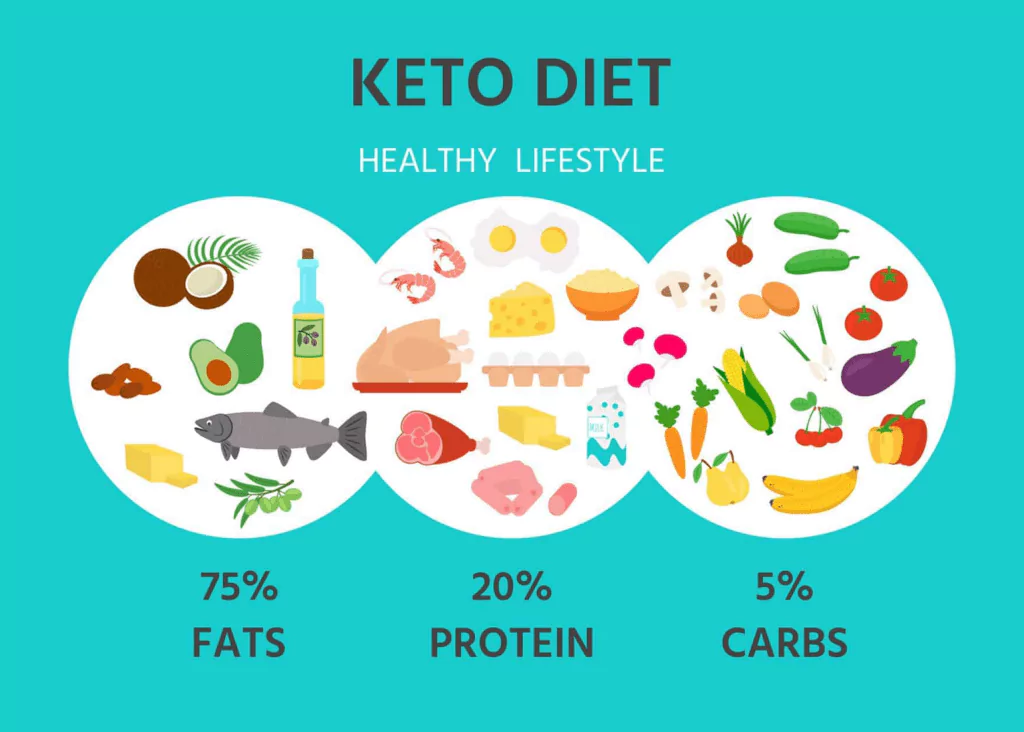Table of Contents
Discover the transformative power of the Keto Diet Plan and embark on a journey towards a healthier and more vibrant life. Uncover the science behind ketosis, set clear goals, and explore advanced strategies for optimal results. Your path to wellness begins here.

Welcome to the world of boundless energy, vibrant health, and a slimmer, more confident you! In today’s fast-paced world, where staying healthy is a top priority, the Keto Diet Plan shines as a beacon of hope for those seeking a transformative lifestyle change.
The Keto Diet Plan isn’t just a diet; it’s a life-altering journey that promises a healthier, happier you. With its roots firmly grounded in science and a legion of success stories, this dietary approach is more than just a trend—it’s a proven path to wellness.
Imagine waking up each day with a surge of energy that propels you through your day, mental clarity that sharpens your focus, and a body that feels lighter and more agile. This is the power of keto, and in this comprehensive guide, we will unlock its secrets.
People from all walks of life are turning to the Keto Diet Plan, and for good reason. This lifestyle transformation offers not only effective weight management but also numerous health benefits, from improved insulin sensitivity to enhanced heart health. Whether you’re here to shed those stubborn pounds, gain mental clarity, or simply lead a more positive lifestyle, keto has something extraordinary to offer.
We will demystify the keto diet, providing you with the knowledge and tools to embark on your own path to a healthier future. From understanding the science behind ketosis to setting achievable goals and exploring advanced strategies, we’ve got you covered.
Keto Diet Plan: What Is It?
The Essence of Ketosis
At its core, the Keto Diet Plan is all about ketosis, a metabolic state that transforms your body’s energy source. Instead of relying on carbohydrates, your body shifts gears to burn fat for fuel. This fundamental shift holds the key to weight loss and improved well-being.
Understanding the Ketogenic Diet
To grasp the Keto Diet Plan fully, it’s vital to understand the ketogenic diet itself. This low-carbohydrate, high-fat diet forces your body into a state of ketosis. But what exactly happens when your body becomes a fat-burning machine? Let’s delve into the science.
The Science Behind Ketosis
Ketosis occurs when you drastically reduce your carbohydrate intake, typically to less than 50 grams per day. As your carb intake dwindles, your body begins breaking down fat stores into molecules called ketones. These ketones serve as an alternative energy source, effectively replacing glucose.
By shifting to ketones, your body enters a state where fat becomes the primary fuel, leading to weight loss. But it doesn’t stop there. Ketosis also brings forth several health benefits, including better mental clarity and improved insulin sensitivity. It’s a state where the body operates at its peak efficiency, promoting overall well-being.
Getting Started with Keto
Setting Clear Goals: Your Roadmap to Success
Before you dive headfirst into the Keto Diet Plan, it’s crucial to establish clear and attainable goals. This is your roadmap to success. By defining what you aim to achieve with keto, you’ll stay motivated and focused on your journey.
Calculating Your Macros: The Science of Balance
The heart of the Keto Diet Plan lies in macronutrients—fats, proteins, and carbohydrates. To succeed, you need to calculate and balance these components effectively. Here’s how:
Determining Your Macronutrient Ratios
- Fats: Aim for approximately 70-75% of your daily caloric intake from healthy fats. These include avocados, nuts, seeds, and olive oil.
- Proteins: Consume about 20-25% of your calories from protein sources such as lean meats, poultry, and fish.
- Carbohydrates: Limit your daily carb intake to a mere 5-10% of your calories. Focus on low-carb vegetables like leafy greens and cruciferous veggies.
Planning Your Meals: The Keto Kitchen
Creating a well-structured meal plan is the cornerstone of your keto journey. Here’s how to build keto-friendly meals that align with your macronutrient goals:
Keto-Friendly Foods
- Healthy Fats: Incorporate avocados, coconut oil, nuts, and fatty fish into your daily meals.
- Proteins: Opt for lean meats like chicken and turkey, and fatty fish like salmon and mackerel.
- Low-Carb Vegetables: Load up on leafy greens, broccoli, cauliflower, and zucchini.
- Keto-Friendly Dairy: Include sources like full-fat yogurt and cheese, but in moderation.
- Sweeteners: Use keto-approved sweeteners like stevia or erythritol sparingly.
Meal Preparation: Your Time-Saver
Meal prepping can be a game-changer in your keto journey. By cooking in batches, you save time and ensure that you always have keto-friendly options available.
Tips for Effective Meal Prep
- Plan Ahead: Decide what meals you’ll prepare for the week.
- Batch Cooking: Cook large portions of keto-friendly dishes like casseroles or stews.
- Portion Control: Divide meals into individual servings for easy access.
- Keto Snacks: Keep keto snacks on hand to curb cravings and stay on track.
- Labeling: Label containers with the date to track freshness.
With clear goals, a solid understanding of macros, and effective meal planning, you’re well-equipped to embark on your Keto Diet Plan journey towards a healthier and more vibrant you.
Benefits of the Keto Diet
The Keto Diet Plan offers a multitude of diet benefits that go beyond just shedding pounds. Let’s explore how this transformative lifestyle can positively impact your well-being.
Weight Loss: Shedding Pounds Effectively
One of the most significant and well-documented benefits of the Keto Diet Plan is weight loss. By shifting your body’s energy source from carbohydrates to fat, you enter a state of continuous fat burning. This leads to not only rapid initial weight loss but also long-term weight management.
Improved Insulin Sensitivity: Regulating Blood Sugar
Keto can be a game-changer for individuals with insulin resistance or prediabetes. By reducing carb intake and focusing on fat as an energy source, the Keto Diet Plan helps stabilize blood sugar levels. This can lower the risk of developing type 2 diabetes and enhance overall health.
Enhanced Mental Clarity: Fueling Your Mind
Many keto enthusiasts report heightened mental clarity and improved cognitive function. By utilizing ketones as an energy source, the brain benefits from a consistent and efficient fuel supply. This can lead to better focus, memory, and mental sharpness.
Increased Energy Levels: Steady and Sustainable
Unlike the energy rollercoaster that often accompanies high-carb diets, keto provides a steady and sustainable source of energy. No more post-lunch crashes or afternoon slumps. With ketones, you experience stable, all-day vitality.
Appetite Suppression: Control Over Cravings
Keto can help curb hunger and reduce cravings. With a diet rich in satisfying fats and proteins, you’re less likely to experience the pangs of hunger, making it easier to adhere to your dietary goals.
Better Heart Health: Lowering Bad Cholesterol
Contrary to popular belief, a well-balanced Keto Diet Plan can improve heart health. It often leads to a decrease in triglycerides and an increase in high-density lipoprotein (HDL) cholesterol, commonly referred to as “good” cholesterol. This can reduce the risk of heart disease.
Epilepsy Management: A Proven Treatment
Originally developed as a treatment for epilepsy, the Keto Diet Plan has a long history of successfully managing this condition, particularly in children. It can significantly reduce the frequency and severity of seizures in those with epilepsy.
With these remarkable benefits, the Keto Diet Plan goes beyond weight loss, offering a holistic approach to enhancing your overall health and well-being. Whether you’re looking to shed pounds, stabilize your blood sugar, or experience better mental clarity, keto has the potential to transform your life.
Keto Diet Plan for Beginners
Starting your journey with the Keto Diet Plan can be both exciting and a bit challenging, especially if you’re new to the world of low-carb, high-fat eating. Here, we’ll guide you through the essential steps to ensure a successful and comfortable beginning.
Overcoming the Keto Flu
What Is the Keto Flu?
The Keto Flu is a common side effect of transitioning into ketosis. It typically occurs during the initial stages of the diet as your body adjusts to its new fuel source. Symptoms may include fatigue, headaches, dizziness, nausea, and irritability.
How to Alleviate the Keto Flu
- Stay Hydrated: Drink plenty of water to flush out toxins and help your body adapt.
- Increase Electrolytes: Replace lost electrolytes through foods like avocados and leafy greens or with supplements.
- Gradual Transition: Ease into keto by gradually reducing your carb intake over a few days.
- Adequate Rest: Get enough sleep to support your body during the adaptation phase.
- Be Patient: Understand that the discomfort is temporary, and it’s a sign that your body is adapting to ketosis.
Meal Prepping Tips
Simplify Your Keto Journey
Meal prepping can make your keto experience more convenient and enjoyable. Here are some tips to simplify your journey:
- Plan Ahead: Decide what meals you’ll eat during the week and create a shopping list.
- Batch Cooking: Prepare large batches of keto-friendly dishes that can be reheated throughout the week.
- Keto Snacks: Stock up on keto-friendly snacks like nuts, cheese, and pork rinds for those moments of hunger.
- Labeling: Use containers and labels to organize and identify your prepared meals.
Staying Hydrated
The Importance of Hydration on Keto
Proper hydration is crucial on the Keto Diet Plan. As your body adapts to ketosis, you may lose more water and electrolytes, making it essential to stay adequately hydrated.
Tips for Staying Hydrated
- Drink Water Regularly: Aim for at least eight glasses of water a day.
- Electrolytes: Include foods rich in electrolytes, like avocados and leafy greens.
- Keto-Friendly Drinks: Opt for keto-friendly beverages like herbal tea, coffee with unsweetened almond milk, or infused water.
By following these tips and being mindful of the initial challenges, you can ease into the Keto Diet Plan with confidence. Remember that the discomfort of the Keto Flu is temporary, and the long-term benefits of keto are well worth the effort.
Advanced Keto Strategies
Once you’ve mastered the basics of the Keto Diet Plan, it’s time to explore advanced strategies that can further optimize your results and make your journey even more rewarding.
Intermittent Fasting
The Synergy of Keto and Intermittent Fasting
Combining the principles of keto with intermittent fasting can be a powerful way to enhance weight loss and overall health. Intermittent fasting involves cycling between periods of eating and fasting. Here’s how to make it work for you:
- Choose a Fasting Window: Decide on the duration of your fasting window. Common options include 16/8 (16 hours of fasting, 8 hours of eating) or 18/6.
- Stay Hydrated: During fasting hours, continue to drink water, herbal tea, or black coffee (without added sugars or cream).
- Break Your Fast Mindfully: When it’s time to eat, prioritize whole, nutrient-dense foods that align with your keto goals.
- Monitor Your Body: Pay attention to how your body responds and adjust your fasting window as needed.
Targeted Keto
Precision Fueling for Active Individuals
Targeted keto is a modified version of the standard keto diet that allows for a small intake of carbohydrates around workouts. This strategy is particularly beneficial for athletes and active individuals looking to optimize their performance. Here’s how to implement targeted keto:
- Timing Is Key: Consume a small amount of fast-acting carbohydrates, like a banana or honey, 30 minutes to an hour before your workout.
- Monitor Your Performance: Pay attention to how your body responds during workouts. You should experience improved energy levels and endurance.
- Choose Quality Carbs: Opt for high-quality, natural carbohydrates that won’t derail your keto progress.
Cyclical Keto
Flexibility While Maintaining Benefits
Cyclical keto, often referred to as “carb cycling,” involves cycling in and out of ketosis at planned intervals. This approach offers flexibility while still reaping the benefits of keto. Here’s how it works:
- Plan Your Carb Intake: Designate specific days or periods where you’ll consume a higher amount of carbohydrates.
- Strict Keto on Off-Days: On non-carb days, stick to a strict keto diet.
- Monitor Your Body: Pay attention to how your body responds and adjust your cyclical keto schedule as needed.
- Consult a Professional: Before adopting cyclical keto, consult with a healthcare professional or nutritionist to ensure it aligns with your goals.
These advanced keto strategies can take your Keto Diet Plan to the next level, allowing you to tailor your approach to your unique needs and goals. Whether you’re seeking enhanced athletic performance or greater dietary flexibility, these strategies offer valuable options for success.
Common Keto FAQs
As you embark on your Keto Diet Plan journey, you’re likely to encounter several common questions and uncertainties. Let’s address these frequently asked questions to provide you with clarity and confidence in your keto adventure.
Can I Have Fruit on the Keto Diet?
Balancing Fruit and Keto
While many fruits are naturally high in carbohydrates due to their sugar content, some can still be incorporated into your keto diet in moderation. Here are some keto-friendly fruits:
- Berries: Berries like strawberries, blueberries, and raspberries are lower in carbs and can be enjoyed in limited quantities.
- Avocado: Although technically a fruit, avocados are keto-friendly due to their high healthy fat content.
Remember to monitor your carbohydrate intake and adjust your fruit consumption to stay within your daily carb limit.
Is the Keto Diet Safe for Everyone?
Safety First on Keto
The keto diet is generally safe for most people when followed correctly. However, it may not be suitable for everyone. Consider these factors:
- Underlying Health Conditions: If you have diabetes, liver or pancreatic issues, or a history of eating disorders, consult with a healthcare professional before starting keto.
- Medications: Some medications may interact with keto, so it’s essential to discuss your diet with your healthcare provider.
- Pregnancy and Breastfeeding: Pregnant or breastfeeding individuals should be cautious and consult a healthcare professional for guidance.
How Long Does It Take to Reach Ketosis?
Timing Your Ketosis
The time it takes to enter ketosis can vary from person to person. Typically, it takes a few days to a week of following a strict keto diet. Here’s a general timeline:
- Day 1-3: Your body starts depleting its glycogen stores.
- Day 3-7: Ketosis begins as your body adapts to burning fat for fuel.
Remember that factors like individual metabolism, carb intake, and activity level can influence the speed of reaching ketosis.
Can I Drink Alcohol on Keto?
Enjoying Alcohol in Moderation
While alcohol can be consumed on keto, it should be done in moderation and with awareness of its impact on ketosis. Here are some keto-friendly alcoholic options:
- Dry Wine: Dry wines like red or white wine have fewer carbs than sweet varieties.
- Hard Liquor: Spirits like vodka, whiskey, and tequila contain zero carbs.
- Low-Carb Beer: Some low-carb beer options are available.
Always consume alcohol responsibly, and be mindful of its carb content, as it can affect ketosis.
What Are Some Common Keto-Friendly Sweeteners?
Satisfying Your Sweet Tooth
If you have a sweet tooth, there are keto-friendly sweeteners you can use:
- Stevia: A natural, calorie-free sweetener derived from the stevia plant.
- Erythritol: A sugar alcohol with minimal impact on blood sugar.
- Monk Fruit Sweetener: A natural sweetener with zero carbs.
These sweeteners can be used as alternatives to sugar in your keto-friendly recipes.
How Can I Prevent Keto Constipation?
Dealing with Digestive Issues
Keto constipation can be a common issue due to the diet’s lower fiber intake. To alleviate this discomfort, consider the following:
- Increase Fiber: Consume more fiber-rich, low-carb vegetables like broccoli, spinach, and cauliflower.
- Stay Hydrated: Drinking enough water is essential for proper digestion on keto.
- Supplements: If needed, consider taking a magnesium supplement to help with bowel regularity.
By addressing these factors, you can reduce the risk of constipation while following the Keto Diet Plan.





More Stories
Transform Your Health: Try the Noom Diet Plan Free Right Now
The Key Ingredients of a Successful Weight Loss Nutrition Program
Unveiling Calorie Secrets: Your Guide to Effective Weight Management